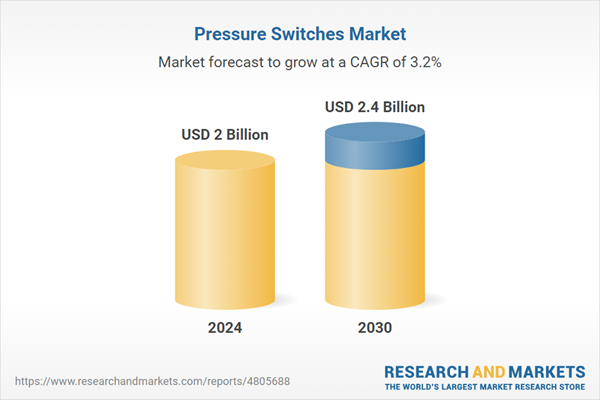The global market for Pressure Switches was valued at US$2.0 Billion in 2024 and is projected to reach US$2.4 Billion by 2030, growing at a CAGR of 3.2% from 2024 to 2030. This comprehensive report provides an in-depth analysis of market trends, drivers, and forecasts, helping you make informed business decisions. The report includes the most recent global tariff developments and how they impact the Pressure Switches market.
Segments: Application (HVAC, Monitoring & Control, Safety & Alarm Systems, Hydraulics & Pneumatics); End-Use (Automotive & Transportation, Process & Manufacturing Industry, Commercial); Pressure Range (Below 100 bar, 100-400 bar, Above 400 bar); Type (Electromechanical, Solid-State).
Geographic Regions/Countries: World; United States; Canada; Japan; China; Europe (France; Germany; Italy; United Kingdom; Spain; Russia; and Rest of Europe); Asia-Pacific (Australia; India; South Korea; and Rest of Asia-Pacific); Latin America (Argentina; Brazil; Mexico; and Rest of Latin America); Middle East (Iran; Israel; Saudi Arabia; United Arab Emirates; and Rest of Middle East); and Africa.
The analysts continuously track trade developments worldwide, drawing insights from leading global economists and over 200 industry and policy institutions, including think tanks, trade organizations, and national economic advisory bodies. This intelligence is integrated into forecasting models to provide timely, data-driven analysis of emerging risks and opportunities.
Global Pressure Switches Market - Key Trends and Drivers Summarized
Pressure Switches: Critical Components in Industrial and Commercial Systems
Pressure switches are electromechanical devices that monitor and control the pressure levels within a system, automatically activating or deactivating equipment when a predetermined pressure threshold is reached. These devices are commonly used in industrial, commercial, and residential systems to ensure safe and efficient operation of equipment such as pumps, compressors, boilers, and HVAC systems. Pressure switches work by sensing pressure changes in gases or liquids and triggering an electrical contact to control the connected equipment. For example, in a water pump system, a pressure switch will turn the pump on when the pressure drops below a certain level and turn it off when the desired pressure is reached. This automation helps maintain consistent pressure, prevent equipment damage, and ensure operational safety, making pressure switches essential components in a wide range of applications.How Are Technological Advancements Enhancing Pressure Switches?
Technological advancements have significantly improved the performance, reliability, and versatility of pressure switches, making them more effective in a variety of applications. The development of solid-state pressure switches has enhanced durability and response time, offering more precise and reliable pressure control without the mechanical wear and tear associated with traditional electromechanical switches. Advances in sensor technology, including the use of piezoelectric and capacitive sensors, have improved the accuracy and sensitivity of pressure switches, allowing for better detection of minute pressure changes. The integration of digital displays and programmable features has enabled more precise control settings and easier calibration, enhancing the usability of pressure switches in complex systems. Additionally, the development of wireless pressure switches has facilitated remote monitoring and control, providing greater flexibility in system design and operation. These technological improvements have expanded the capabilities and applications of pressure switches, making them indispensable in modern industrial and commercial systems.What Are the Key Applications and Benefits of Pressure Switches?
Pressure switches are used in a wide range of applications across various industries, offering numerous benefits that enhance system efficiency, safety, and reliability. In the industrial sector, pressure switches are critical for controlling the operation of pumps, compressors, and hydraulic systems, ensuring that these systems maintain optimal pressure levels and operate safely. In HVAC systems, pressure switches are used to monitor and regulate the pressure of refrigerants and air, preventing system failures and ensuring efficient climate control. Pressure switches are also used in automotive applications, such as monitoring tire pressure and controlling brake systems, where precise pressure management is crucial for vehicle safety and performance. The primary benefits of pressure switches include their ability to provide automated pressure control, enhance system safety, and improve operational efficiency. By ensuring that equipment operates within safe pressure limits, pressure switches help prevent damage, reduce maintenance costs, and extend the lifespan of critical systems.What Factors Are Driving the Growth in the Pressure Switches Market?
The growth in the pressure switches market is driven by several factors. The increasing demand for automation and precision in industrial processes is a significant driver, as pressure switches are essential for maintaining consistent and safe operating conditions in various systems. Technological advancements that improve the accuracy, durability, and functionality of pressure switches are also propelling market growth. The rising adoption of smart and connected devices in industrial and commercial applications is further boosting the demand for advanced pressure switches. Additionally, the expansion of industries such as oil and gas, automotive, and HVAC, which rely heavily on pressure control, is contributing to market growth. The growing focus on energy efficiency and system optimization is also supporting the adoption of pressure switches in various applications. These factors, coupled with continuous innovation in sensor and control technologies, are driving the sustained growth of the pressure switches market.Report Scope
The report analyzes the Pressure Switches market, presented in terms of units. The analysis covers the key segments and geographic regions outlined below.Segments: Application (HVAC, Monitoring & Control, Safety & Alarm Systems, Hydraulics & Pneumatics); End-Use (Automotive & Transportation, Process & Manufacturing Industry, Commercial); Pressure Range (Below 100 bar, 100-400 bar, Above 400 bar); Type (Electromechanical, Solid-State).
Geographic Regions/Countries: World; United States; Canada; Japan; China; Europe (France; Germany; Italy; United Kingdom; Spain; Russia; and Rest of Europe); Asia-Pacific (Australia; India; South Korea; and Rest of Asia-Pacific); Latin America (Argentina; Brazil; Mexico; and Rest of Latin America); Middle East (Iran; Israel; Saudi Arabia; United Arab Emirates; and Rest of Middle East); and Africa.
Key Insights:
- Market Growth: Understand the significant growth trajectory of the Electromechanical segment, which is expected to reach US$1.9 Billion by 2030 with a CAGR of a 3.5%. The Solid-State segment is also set to grow at 2.2% CAGR over the analysis period.
- Regional Analysis: Gain insights into the U.S. market, valued at $520.6 Million in 2024, and China, forecasted to grow at an impressive 5.4% CAGR to reach $525.3 Million by 2030. Discover growth trends in other key regions, including Japan, Canada, Germany, and the Asia-Pacific.
Why You Should Buy This Report:
- Detailed Market Analysis: Access a thorough analysis of the Global Pressure Switches Market, covering all major geographic regions and market segments.
- Competitive Insights: Get an overview of the competitive landscape, including the market presence of major players across different geographies.
- Future Trends and Drivers: Understand the key trends and drivers shaping the future of the Global Pressure Switches Market.
- Actionable Insights: Benefit from actionable insights that can help you identify new revenue opportunities and make strategic business decisions.
Key Questions Answered:
- How is the Global Pressure Switches Market expected to evolve by 2030?
- What are the main drivers and restraints affecting the market?
- Which market segments will grow the most over the forecast period?
- How will market shares for different regions and segments change by 2030?
- Who are the leading players in the market, and what are their prospects?
Report Features:
- Comprehensive Market Data: Independent analysis of annual sales and market forecasts in US$ Million from 2024 to 2030.
- In-Depth Regional Analysis: Detailed insights into key markets, including the U.S., China, Japan, Canada, Europe, Asia-Pacific, Latin America, Middle East, and Africa.
- Company Profiles: Coverage of players such as ABB Group, Barksdale Capital Corporation, Baumer Group, BD Sensors GmbH, Danfoss A/S and more.
- Complimentary Updates: Receive free report updates for one year to keep you informed of the latest market developments.
Some of the 14 companies featured in this Pressure Switches market report include:
- ABB Group
- Barksdale Capital Corporation
- Baumer Group
- BD Sensors GmbH
- Danfoss A/S
- Eaton Corporation PLC
- Emerson Electric Co.
- Fox Srl
- Honeywell International, Inc.
- Parker Hannifin Corporation
- Robert Bosch GmbH
- Schlumberger Ltd.
- Schneider Electric SA
- SMC Corporation
Tariff Impact Analysis: Key Insights for 2025
Global tariff negotiations across 180+ countries are reshaping supply chains, costs, and competitiveness. This report reflects the latest developments as of April 2025 and incorporates forward-looking insights into the market outlook.The analysts continuously track trade developments worldwide, drawing insights from leading global economists and over 200 industry and policy institutions, including think tanks, trade organizations, and national economic advisory bodies. This intelligence is integrated into forecasting models to provide timely, data-driven analysis of emerging risks and opportunities.
What’s Included in This Edition:
- Tariff-adjusted market forecasts by region and segment
- Analysis of cost and supply chain implications by sourcing and trade exposure
- Strategic insights into geographic shifts
Buyers receive a free July 2025 update with:
- Finalized tariff impacts and new trade agreement effects
- Updated projections reflecting global sourcing and cost shifts
- Expanded country-specific coverage across the industry
Table of Contents
I. METHODOLOGYII. EXECUTIVE SUMMARY2. FOCUS ON SELECT PLAYERSIII. MARKET ANALYSISCANADAITALYSPAINRUSSIAREST OF EUROPESOUTH KOREAREST OF ASIA-PACIFICARGENTINABRAZILMEXICOREST OF LATIN AMERICAIRANISRAELSAUDI ARABIAUNITED ARAB EMIRATESREST OF MIDDLE EASTIV. COMPETITION
1. MARKET OVERVIEW
3. MARKET TRENDS & DRIVERS
4. GLOBAL MARKET PERSPECTIVE
UNITED STATES
JAPAN
CHINA
EUROPE
FRANCE
GERMANY
UNITED KINGDOM
ASIA-PACIFIC
AUSTRALIA
INDIA
LATIN AMERICA
MIDDLE EAST
AFRICA
Companies Mentioned (Partial List)
A selection of companies mentioned in this report includes, but is not limited to:
- ABB Group
- Barksdale Capital Corporation
- Baumer Group
- BD Sensors GmbH
- Danfoss A/S
- Eaton Corporation PLC
- Emerson Electric Co.
- Fox Srl
- Honeywell International, Inc.
- Parker Hannifin Corporation
- Robert Bosch GmbH
- Schlumberger Ltd.
- Schneider Electric SA
- SMC Corporation
Table Information
| Report Attribute | Details |
|---|---|
| No. of Pages | 232 |
| Published | April 2025 |
| Forecast Period | 2024 - 2030 |
| Estimated Market Value ( USD | $ 2 Billion |
| Forecasted Market Value ( USD | $ 2.4 Billion |
| Compound Annual Growth Rate | 3.2% |
| Regions Covered | Global |









